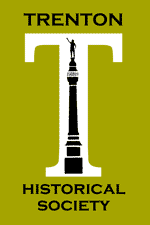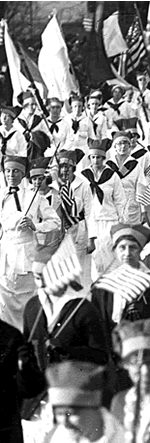



MEMORABLE YESTERDAYS FOR TRENTON
(BY “AN OLD INHABITANT”)
TRENTON SUNDAY TIMES-ADVERTISER, NOVEMBER 26, 1916
No. 57 – When South Trenton Was a Township
A world of quaint and curious information of strictly local interest is embraced
between thecovers of a modest little volume owned by Samuel W. Margerum and
entitled “Nottingham Township Book.” It contains the minutes of
the township meetings from April, 1828, to April, 1849. At that time all South
Trenton from the Assunpink southward was included in Nottingham. Trenton proper
being the section north of the creek. Nottingham was divided, however, on
April 11, 1842, the territory set off being thenceforth known as Hamilton
Township. Before peeping into the interesting contents of the minute book,
it may be said that its excellent state of preservation is worthy of comment.
It is well and substantially bound in sheepskin and the paper, although yellowed
by age is of tough, lasting texture, in which respect it differs vastly from
most of the white paper in use today. The clear, legible penmanship reflects
credit upon the secretaries who did their work before the age of typewriting
aids.
The first township meeting reported in the book occurred April 11, 1828, and
was held at the house of Joshua English. There was no fixed place of meeting,
the committeemen moving from place to place with a view apprently of keeping
in touch with the different sections and incidently of distributing a little
loose coin among the landlords of the township. The last entry in the minutes
each meeting usually was to the effect that a bill of a few dollars for refreshments
was ordered paid. Mr. English got only $1.25 from the meeting in question,
but other bills ran considerably higher. The second meeting was held “at
the house of Margaret Gordon, on Mill Hill”; the third meeting was held
“at the inn of William Howell, of Bloomsbury”; other meetings
were held at the house of Samuel Crossley, Lamberton: at George L. Phillips’s
on Mill Hill; at the White Horse Tavern at Sandtown, at Charles M. Warner’s,
at Thomas Butcher’s, at David Tams, at Davis Schenck’s, etc.
The members who attended the first meeting were Elijah Hutchinson, Samuel
Middleton, Benjamin Fish, David Schenck and Wallaston Redman. At the November
meeting the same year school funds in the following lean amounts were appropriated
for the quarter: Union School, $12; White Horse School, $12; Lamberton School
$12; Nottingham Square, $9; Bloomsbury, $12; Mill Hill, $18; Sandtown, $8;
Groveville, $12; school near Joshua Wrights’s, $9.
The time of the Township Committee was given largely to a consideration of
matters affecting the schools, the roads and the poor, or the paupers as they
were usually denominated in thise days. Among the prominent merchanys of the
time who had bills in for “necessaries” supplied to the poor,
the names of Robert Chambers, George James, John Whittaker, Benjamin Fish,
Lewis Parker and Samuel Wooley appear at frequent intervalls. As high as $150
and $200 was collected at times on a single bill. Professional talent, however,
does not appear to have been extravagantly compensated. Governor Peter D.
Vroom was retained as counsel for the Nottingham Committee (after division
of the township) for $20 per annum, and Dr. Jacob B. James looked after the
sick for $10 per annum. Dr. George L. Robbins and Dr. Peter Howell were employed
at other times.
Robert Chambers, after whom Chambersburg is named, was one of the early secretaries
of the committee. James B. Coleman, later an eminent physician, also filled
this office. J. H. Rulon was still another secretary, Mayor Franklin S. Mills
was at times secretary and again he was a member of the committee.
According to the minutes of February 26, 1831, reports were received from
the overseers of roads as follows: William Tilton, First District, expended
$105.90; John H. Rulon, Second District, $124.29; Robert Phares, Third District,
$162.06; Benjamin South, Fourth District, $360.37; Thomas A. Ashmore, Fifth
District, $181.25; total, $938.37. These presumably were annual expenditures.
After the digging of the Delaware and Raritan Canal in the early ‘30’s
Trenton was visited by an attack of cholera and we find that at the July meeting
(1832) of the Nottingham committee, the Board of Health for Mill Hill, Lamberton
and Bloomsbury was authorized to the extent of $100 to make expenditures for
impecunious cases that might arise. At the August meeting it was found necessary
to allow a larger sum, in order to provide a temporary hospital, and a portion
of the public burial ground belonging to the township was directed to be set
off for the use of Roman Catholics so that they might consecrate it according
to their own rites. No further meeting of the township committee was held
till the following March.
Bills were very critically examined. For instance Dr. E. L. Dubarry presented
a bill of $14 for attending a pauper woman in confinement and the committee
cut the amount down to $10.
A frequent item of expense allowed against the township was for sheep killed
by dogs, the attempt being made each year to keep the amount of damages within
the sum collected for dog licenses.
It was decided March 5, 1836, that thereafter the cost of burying a pauper
should not exceed $5.
The unenclosed land belonging to the township for a public burial ground,
was leased to Robert Wright to cultivate “in any way he may think proper”
and for that privilege to keep the burial ground fence in order, Mr. Wright
to turn the property back to the township when needed.
A joint meeting of the committees of Nottingham and Hamilton Townships, following
the division of the township, was held on April 18, 1842, with these members
present:
Nottingham, Joseph Ashmore, Gershom Mott, Lewis Parker, Daniel Lodor and Franklin
S. Mills.
Hamilton- John H. Rulon, Enoch Middleton, Enoch Knowles, James B Coleman.
It took several meeting of the two bodies before the public business concerning
the two townships was cleared up and a financial balance was struck. A meeting
was held September 10 and one of the matters disposed of was to vote the members
$1 per day for time spent in settling the joint affairs of the township. The
secretary was allowed $1.50. It was not till April 5, 1843, that the two townships
agreed upon final terms, which were that Nottingham should receive and be
liable to pay $34 in every hundred and Hamilton should receive and be liable
to pay $66 in every hundred.
The first meeting of the new Nottingham Township committee was held December
23, 1842, Gershom Mott in the chair and Franklin S. Mills, secretary.
Coming to the later years of which the minute book has a record, we find that
at the anniual meeting of the township committee in April, 1846, the members
present were Joseph Ashmore, Gershom Mott, Charles Gordon, William B. Paul
and John Margerum. Mr. Ashmore was elected president and Mr. Mott, clerk.
The business transacted included the employment of Governor Peter D. Vroom
as counselor at $20 per annum, and Dr. Jacob B. James as township physician
ay $10 per annum, “which is to include any vaccination which he may
do this season.”
Arrangements were made with certain citizens to keep different paupers, the
prevailing weekly rate being 75 cents per person under a six months contract.
In April, 1847, the township committee consisted of James M. Redmond, Gershom
Mott, William B. Paul, Charles Gordon, and Henry M. Lee, Mr. Redmond being
elected president and Mr. Mott re-elected secretary. Governor Vroom was re-elected
solicitor at the same modest stipend and Dr. James was again made township
physician. The year before the doctor was permitted to supply medicines at
an extra cost, but this year “the overseer of the poor is to purchase
medicine wherever he thinks proper.” It looks as if there was some rivalry
for trade among the druggists. Lewis Parker, Jr., was appointed tax collector
and Samuel B. Stafford was town clerk. Arnold & Brittain were selected
to print the annual statement at a cost of $2. The year before Mills &
Glenn had printed it.
An entry of interest concerning the first public school ever erected in what
is now Trenton, appears in the minutes of August 4, 1845. The school (now
known as the Charles Skelton) had been opened the year before on Centre Street,
and at the August meeting in question Mr. Franklin S. Mills submitted a resolution,
at the School Committee’s request, for the raising of $1,500 on mortgage.
In pursuance of the resolution, a public town meeting was called for August
14, at the house of Jane Vanderveer. The meeting approved the loan.
At the November meeting (1847) Dr. Charles Skelton having removed out of the
township to the city proper (north of the Assunpink), hasd resigned as school
superintendent and Jacob R. James was elected to succeed him. Lewis Parker
and Samuel Wooley became the new superintendent’s sureties in the sum
of $1,000.
Upon reorganization of the township committee in 1848, Mr. Mott became president
and Franklin S. Mills, secretary. Charles Hewitt’s name appears as superintendent
of schools. At the November meeting, the death of Mr. Mott was reported and
resolutions of regret were adopted. James Howell, of Lamberton, was elected
to fill the vacancy created by Mr. Mott’s death. James L. Southard was
chosen as president.
From the first to the last page of the book there does not appear to have
been any serious problem of government – if we except the transactions
pertaining to a division of the township – but no doubt the smaller
matters of public concern gave the Nottingham Fathers anxious moments and
at times there were probably lively debates that were thought not proper subjects
of record. Taken all in all, the little volume is one worthy of careful preservation
as a local historic document.
Up To Top /
Home
The Society : About Us / Artifacts
Committee / Education Committee / Preservation
Committee / Membership / Contact
Us / Events
Our History : Sights & Sounds
/ 1929 History / Old
& New / Hill Diaries / Chronological
Indexes / Trenton Made / Documents / Tours
Your Ancestors : Research Services
/ Obituaries / City
Directories / High School Yearbooks /
Cemeteries / Genealogy
The City : Buildings /
Historic Districts / North
Ward Survey / Street Names / Local
Links
Search Our Site
Up
To Top / Home
The Society : Preservation
Committee / Artifacts Committee / Membership / Contact
Us / Events
Our History : Sights & Sounds / 1929
History / Old & New / Hill Diaries/ Chronological
Indexes / Trenton Made
Your Ancestors : Research Services / Obituaries / City
Directories / High School Yearbooks / Cemeteries
The City : Historic Districts / North
Ward Survey / Street Names / Local Links